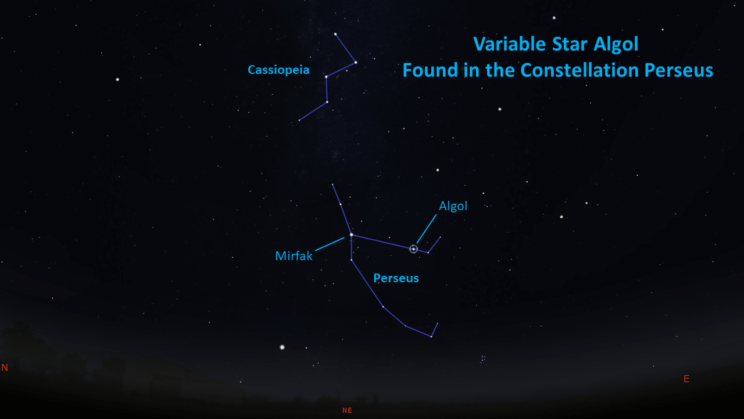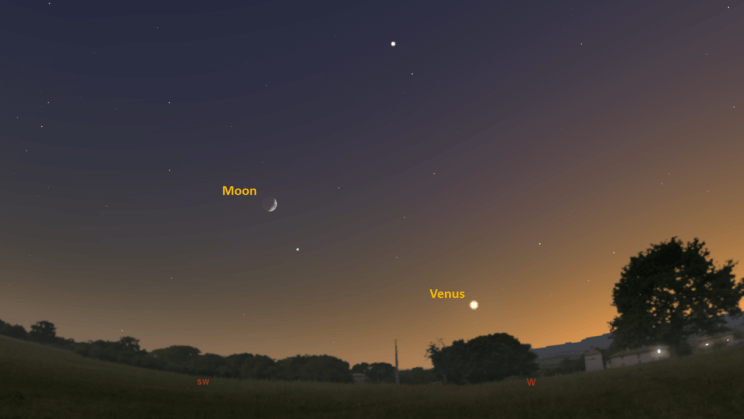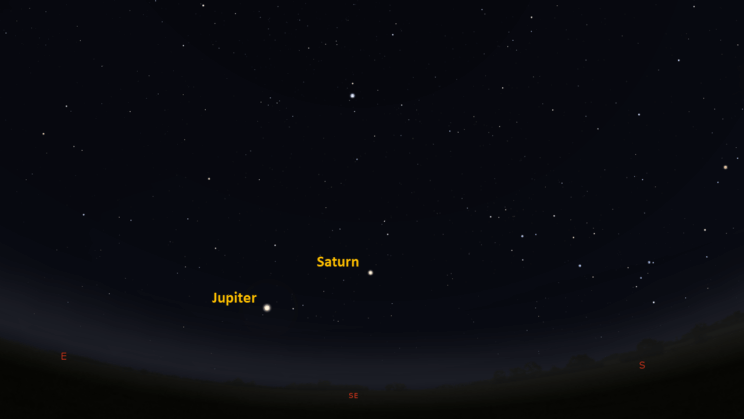This is the Saint Louis Science Center’s NIGHT SKY UPDATE for the week of Friday, August 13, 2021.
Information updated weekly or as needed.
Times given as local St. Louis time, which is Central Daylight Time (CDT). For definitions of terminology used in the night sky update, click the highlighted text. If relying on times posted in Universal Time (UT), St. Louis is -5 hours when CDT.
Public Telescope Viewings
With the changing recommendations from the CDC regarding COVID-19, conversations regarding the return of star parties at the Saint Louis Science Center have begun. We are close to bringing back our public telescope viewings, but a few details still need to be worked out. We will post future updates as we learn more about when we can bring back telescope viewings.
Observing Highlight of the Week

The constellations Perseus and Cassiopeia seen in the northeast after midnight on August 13, 2021.
Graphic created using Stellarium
This week we will talk about an interesting star called Algol (Beta Persei). This famous star is the second brightest in the constellation Perseus. Ancient astronomers would have been aware of Algol as Perseus can be found in the oldest catalogs of astronomical objects. One such list is called the MUL.APIN which lists Perseus by the Sumerian name MUL SU.GI meaning “The Old One.” At 2.1 magnitude, Algol is plainly visible to the unaided eye even if viewing in light pollution. If you watched this star for several nights, you might notice something interesting happens. Every 2.87 days, Algol dramatically dims.
Stars that vary in magnitude are called variable stars. There are numerous types, but Algol is called an eclipse binary. Algol is a triple star consisting of two stars that orbit one another while a much fainter third star orbits the pair. Every 2.87 days, Algol dims from 2.1 magnitude to 3.4 magnitude for about 10 hours. This happens because the two primary stars in the Algol system eclipse one another. There are two eclipses, but the one visible to backyard astronomers occurs when the fainter K-class sub-giant star eclipses the brighter B-class main sequence star. You can find out when the next minima of Algol occurs by using the calculator published by Sky and Telescope magazine here.
Finding Algol is easy if you can find Perseus. To find Perseus, start with the constellation Cassiopeia. She appears as a W-shape of stars visible in the northeast by 10:00 p.m. this week. Perseus extends from the W-shape down to the northeast horizon stopping just north of the Pleiades star cluster. Perseus does not have an obvious shape, but I see a crooked upside-down Y-shape of stars. Algol is the bright star seen south of Perseus’s brightest star Mirfak.
If you find variable stars interesting, I recommend visiting the AAVSO website. Here you can learn about variable stars, plot star maps record observations if so inclined.
The Sun and Moon

The Moon as seen from the International Space Station, on July 31, 2011.
Credit: NASA
Sunrise is at 6:14 a.m. on Friday, August 13 and sunset is at 7:57 p.m. providing us with under 14 hours of daylight. Even after sunset, the light from the Sun will dimly illuminate our sky for roughly 1 hour and 40 minutes. This period is called twilight, which ends around 9:37 p.m. this week. For those with a sundial, local noon occurs around 1:06 p.m. this week.
| Day | Sunrise | Sunset |
|---|---|---|
| 2021-08-13 | 6:14 a.m. | 7:57 p.m. |
| 2021-08-14 | 6:15 a.m. | 7:56 p.m. |
| 2021-08-15 | 6:15 a.m. | 7:55 p.m. |
| 2021-08-16 | 6:16 a.m. | 7:54 p.m. |
| 2021-08-17 | 6:17 a.m. | 7:52 p.m. |
| 2021-08-18 | 6:18 a.m. | 7:51 p.m. |
| 2021-08-19 | 6:19 a.m. | 7:50 p.m. |
| 2021-08-20 | 6:20 a.m. | 7:48 p.m. |
| 2021-08-21 | 6:21 a.m. | 7:47 p.m. |
Moon
Moonrise for Friday, August 13 occurred at 11:34 a.m. and moonset will occur at 11:03 p.m. On Friday, August 13 the Moon will exhibit a waxing crescent phase with about 32% of the lunar disk illuminated. First quarter moon occurs on August 15 at 10:20 a.m.
International Space Station (ISS) Observing

Visible passes of ISS from St. Louis for the week of August 13 occur during morning hours. The best pass this week occurs on the morning of August 21. Use the table below for information about this and other visible passes this week.
Catch ISS from St. Louis starting Friday, August 13
| Date | Starts | Max. altitude | Ends | |||||||
|---|---|---|---|---|---|---|---|---|---|---|
| Time | Alt. | Az. | Time | Alt. | Az. | Time | Alt. | Az. | ||
| 21 Aug | -1.3 | 05:50:42 | 10 | S | 05:53:12 | 19 | SE | 05:55:42 | 10 | E |
Magnitude (Mag): The Measure of brightness for a celestial object. The lower the value is, the brighter the object will be.
Altitude (Alt): The angle of a celestial object measured upwards from the observer’s horizon.
Azimuth (Az): The direction of a celestial object, measured clockwise from an observer’s location with north being 0°, east being 90°, south being 180° and west being 270°.
For information about ISS flyovers and other visible satellites, visit www.heavens-above.com
Detailed information regarding all unmanned exploration of our universe, missions past, present, and planned, can be found at Jet Propulsion Laboratories:
The Visible Planets

Looking West, at 8:30 p.m. August 13, 2021
Credit: Stellarium, EG

Looking Southeast, at 9:30 pm, August 13, 2021
Credit: Stellarium, EG
This week, three naked eye planets are visible. Venus be found in the west after sunset. Jupiter and Saturn can be found in the southeast by 10:00 p.m.
Venus
Venus is well into another evening apparition. By 8:20 p.m., Venus will be about 14° above the western horizon. Venus will set at 9:27 p.m. As 2021 continues, we will see Venus climb higher in the western sky after sunset until October 29 when it reaches maximum eastern elongation. After this date Venus will start to head back towards the Sun as it approaches inferior conjunction on January 8, 2022.
Jupiter
Jupiter rises at 8:15 p.m. and will be easy to see in the southeast by 9:15 p.m. Jupiter will reach opposition this week on August 19, 2021. After this date, Jupiter will be easy to see 30 minutes after sunset in the southeast
Saturn
Saturn is past opposition which means it will be visible about 30 minutes after sunset. Right now, it can be found in the southeast after sunset, but as we continue through the year, Saturn will set about 30 minutes earlier each night. Saturn will reach superior conjunction on February 4, 2022.
James S. McDonnell Planetarium
Night Sky Update: August 13-August 21, 2021






